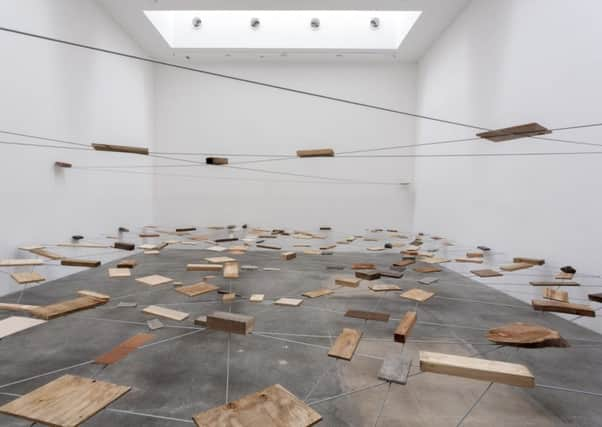Art reviews: Karla Black/Kishio Suga | Ella Kruglanskaya


Karla Black/Kishio Suga ****
Scottish National Gallery of Modern Art, Edinburgh
Ella Kruglanskaya ***
Tramway, Glasgow
Black uses materials that are more familiar in other contexts, over the years they have included pungent domestic unguents, soap, earth, sellotape and ground chalk. She has the knack of making a crushed bath bomb from high street retailer Lush seems as obvious a sculptural material as plaster. Allied to this is a kind of gravity defying mystery around how her fragile forms achieve a stable whole. The other week at London’s Frieze Art Fair I saw a wonderful example: a huge and enigmatic ball of golden sawdust.
At the SNGMA the Glasgow School of Art graduate is paired with a very different artist of a very different generation but with a shared interest in the transformation of the quotidian and the everyday. Kishio Suga, now in his early seventies and a major figure in his native Japan, was part of the Mono-ha movement of artists who in the 1960s sought to transform the Japanese avant-garde through the use of both natural and industrial materials in their most basic forms.
Advertisement
Hide AdAdvertisement
Hide AdMono-ha, like US minimalism or European Arte Povera, favoured stripped-back forms, simple methods and strong gestures. In Edinburgh you see this from the get-go: entering Black’s sculptural world slowly through an interim world of white cotton, you meet Suga head on through a vast block of wood that is wedged into a gallery door like a pit prop.
Both artists are interested in how material objects change the spaces they occupy. One of Suga’s lightest touches is the restaging of Infinite Situation, a 1972 work that uses wooden beams to simply prop open the window. On a far more elaborate scale Left-Behind Situation is a two tier spider’s web created by stringing wire rope horizontally through the gallery space. Caught in the web, are a casual array of objects and offcuts including wood sourced from storm-damaged trees in the gallery’s grounds.
This is a welcome chance to get to the know the work of Suga, under-exhibited in Europe, and a long-overdue and well-deserved show by Black, one of the most strikingly original artists to emerge from the close-knit Glasgow scene of the last two decades – a former Turner prize nominee recognised widely in the US and Europe as an artist of originality and authentic innovation. If her work, which hovers between sculpture and painting, can sometimes feel exuberant to the point of oppressiveness, it is cooler and more clinical in the light of autumnal Edinburgh than one might have expected. At times in the show one sometimes longs for the fragile and rather terrifying pyramids of earth and sawdust that she has created in the past.
Suga’s work describes boundaries: a wooden shelf rammed against a gallery wall, a chain link fence bounded by brick and punctured. A vast boulder balances on four ropes that slice the gallery space into quadrants. Black patrols a different frontier; her artworks describe the point of contact between materials through messy, transformative processes like absorption or adhesion. Such processes are never complete – in Edinburgh pastel-coloured paint drips from a gluey cellophane sheet leaving a milky yellow puddle below, or dries out and slips in shattered fragments to the floor. In Black’s malleable universe the possibilities seem open and ongoing.
At Tramway in Glasgow the paintings of Latvian-born New Yorker Ella Kruglanskaya are all tits and ass: pouting ladies giggle and drink cocktails or sunbathe in the tightest of swimwear whilst glancing or glaring back at the world that observes them. These naughty postcard images are playful satires of art history’s fondess for fantasy female flesh, a world where a lobster’s rosy shell seems more robust than the sketchy human form.
Kruglanskaya’s high camp exuberance and sardonic humour are funny and infectious, but at times the works seems to simply replicate the problem they purport to satirise rather than changing the terms of reference altogether. Kruglanskaya’s more recent paintings show vessels from tea pots to lidded beer mugs, each sitting on a textile surface. Their solid rendering seems a deliberate riposte to the fictional fragmented females. But they also remind us that a vessel, jug or vase in 17th century Dutch genre painting, or in the background of a frothy picture of a young woman in 18th century France, was no innocent observation of a household object. As Professor Martin Kemp once wrote of Glasgow University’s paintings by the French master Chardin, such a vessel might be understood as a uterine metaphor. In Kruglanskaya’s art there’s no escaping sex, even when contemplating tea. ■
MOIRA JEFFREY
Karla Black/Kishio Suga until 19 February 2017; Ella Kruglanskaya until 11 December